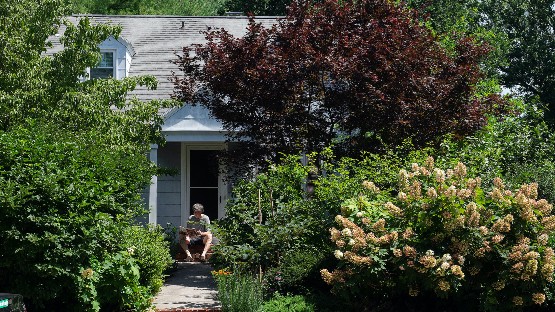
I’ve always thought peoples’ yards say something about their owners. My eighth-acre plot in the city of Salisbury, MD, is shaggy and cluttered, a study in dishevelment, testament to fecund dishabille. Indulgent — but underlain by purpose, great and small.
I began the essay known as 225 South Blvd. some 15 years ago, and it is now as good as anything I’ve put between the covers of a book. Began it with crabgrass and a shovel, fueled by an aversion to mowing and to raking leaves (it still astonishes me how radical that last notion remains).
I was inspired by reporting trips to some of the world’s finest forests and by my buddy Nick Carter’s old farm in the Choptank River watershed that he and wife, Margaret, have been reverting to nature for more than half a century.
Over the years I’ve compared my budding enterprise to a journalist advocating free speech, the soils allowed to utter all their notes rather than drone the tone of lawn.
I also touted it for sequestering carbon, slowing and purifying runoff to the Chesapeake Bay, boosting migrators and pollinators and reducing energy use by adding summer shade.
But truthfully, I just wanted to see leaves and berries and blossoms out every window of my urban bungalow. Shovel by shovel, plant by plant as budget allowed, a loose plan took shape.
I wanted winter interest, which led to hollies and American osmanthus and interesting bark river birch, paperbark maples, heptacodium. (Some know the latter as seven-son flower). Fall color dictated black gums and fothergilla.
A bevy of witch hazels blaze in February and March, as well as a little, underutilized bush known as leatherwood, which not only blossoms reliably in deepest winter, but does so in deepest shade.
Fragrance seems a good thing, so I deployed many native azaleas, which blossom in spring and come from seeds collected in the 1950s along the Choptank River near Nick’s place. They are followed by fringe trees, whose May panicles of sweetish, frothy cream tell me it’s time to paddle the nearby Pocomoke River, where they festoon the forested banks.
And oaks! Oaks are hot tickets in the last few years thanks to the efforts of botanist and author Doug Tallamy, whose research has confirmed that of all native trees, oaks offer the best eatin’ for insectivorous nesting birds. I have 11 varieties: the usual white and red oak, as well as Oglethorpe, Georgia, Arkansas, turkey, blackjack, dwarf chinquapin and runner oaks, plus a couple I forget.
I hear readers worrying: All those oaks on an eighth of an acre? Doesn’t he know they get big? But take a walk in a forest and see how close many large species grow. I also reserve the right to cut if needed — indeed, I have long since traded my lawn mower for a cordless pole trimmer.
Not all oaks get big, and I’ve found species like tulip poplar, which can soar but also naturally occur in smaller mutations. My plants grow slowly, as I don’t fertilize, except to add a compost made of raked up leaves from Montgomery County, MD. (And why are we transporting Montgomery County’s leaves so far and wide from Montgomery County’s trees? Don’t get me started.)
No slave to native species am I, though I’d guess that of the yard’s 100-plus species 75% are native. Native to where, you might ask — Salisbury, the Delmarva Peninsula, the Mid-Atlantic, the Eastern U.S.? Yes. Even a native of the Midwestern prairie, silphium perfoliatum, or cup plant, whose deep tap root loves my sandy loam and draws more pollinators than any of the others.
Urban verdure-holics like me do have an ace in the hole when it comes to variety: no freakin’ deer, which the Nature Conservancy calls the biggest threat to forest biodiversity in these parts.
Rabbits and squirrels and voles do minimal damage. So it is that gnarly sparkleberries reside here with Alabama crotons, joined by anise plants and five kinds of dogwood and tropical-looking but winter-hardy Ashe magnolia, whose blossoms can span nearly a foot wide. Also maples: red and chalk bark, trident and Japanese. And various buckeyes: bottlebrush, red and painted. It’s a funny thing that even a small yard never seems quite full up.
About the time I could not cram in another tree (except for that shagbark hickory I stuck in the back corner, I discovered Virginia bluebells and other shade-loving groundcovers. And as soon as that’s “done,” I’m thinking about native crossvine and maybe dutchman’s pipe to train up my back fence where I’ve torn off invasive ivy.
Then there’s probably the best habitat my efforts have wrought. You cannot do my kind of yard without dedicating space for a brush pile. Mine is full of songbirds and pretty surely a possum family that nocturnally gnaws on the oyster shells along the drip line of the porch after I shuck some.
My yard has also become something of a memorial in recent years. As loved ones and folks who’ve inspired me die, I name a tree or bush for the departed, hanging aluminum tags on a branch (one didn’t depart after I had named a nice longleaf pine after him, but the pine can wait).
For all of the Bay– and planet-saving reasons to green this place (I’ve even planted the driveway now), I just purely enjoy all of the textures and scents and shapes and botanical knowledge I’ve gained — and the way light reflects off and filters through the plants, how they toss in the breeze as I sip my morning coffee and evening wine or write from my little office shed.
“I wake up each morning torn between saving the world or just enjoying it,” said the writer E. B. White. With my yard I can do a tad of the former and a ton of the latter.
Tom Horton, a Bay Journal columnist, has written many articles and books about the Chesapeake Bay, including Turning the Tide and Island Out of Time. He currently teaches writing and environmental topics at Salisbury University. His views do not necessarily reflect those of the Bay Journal. This article first appeared in the June 2023 issue of the Bay Journal and was distributed by the Bay Journal News Service.










